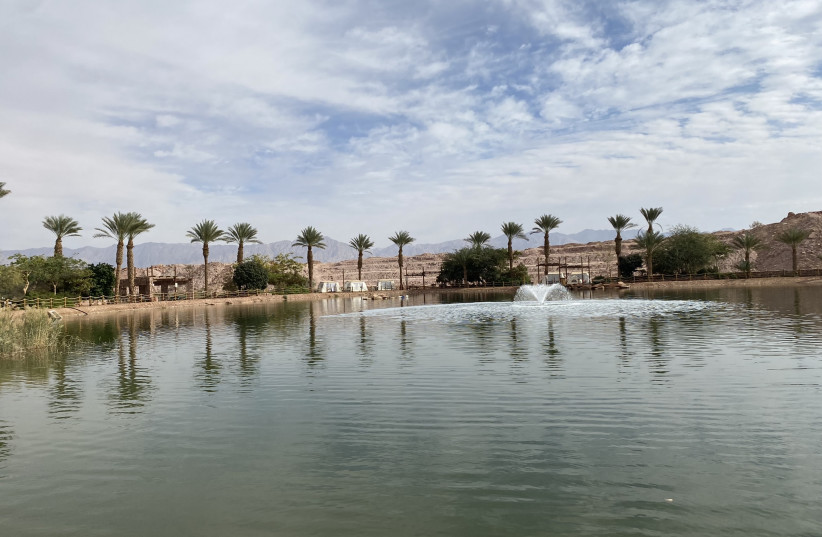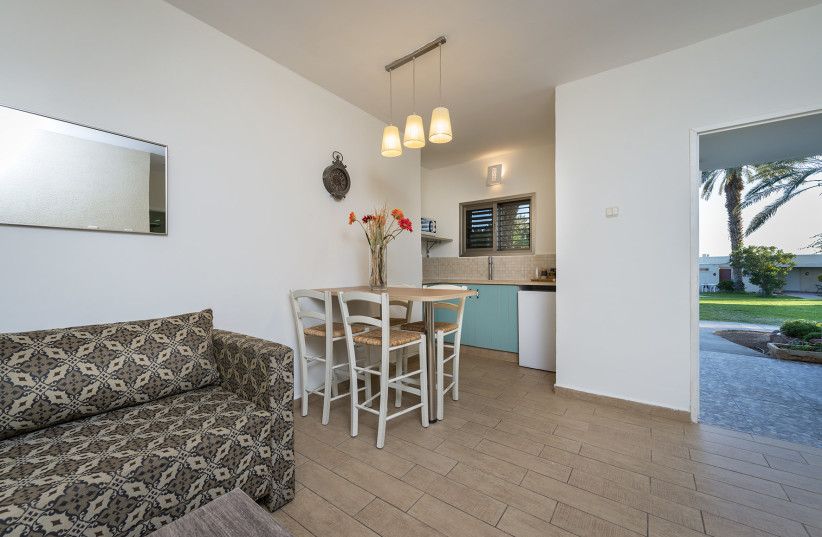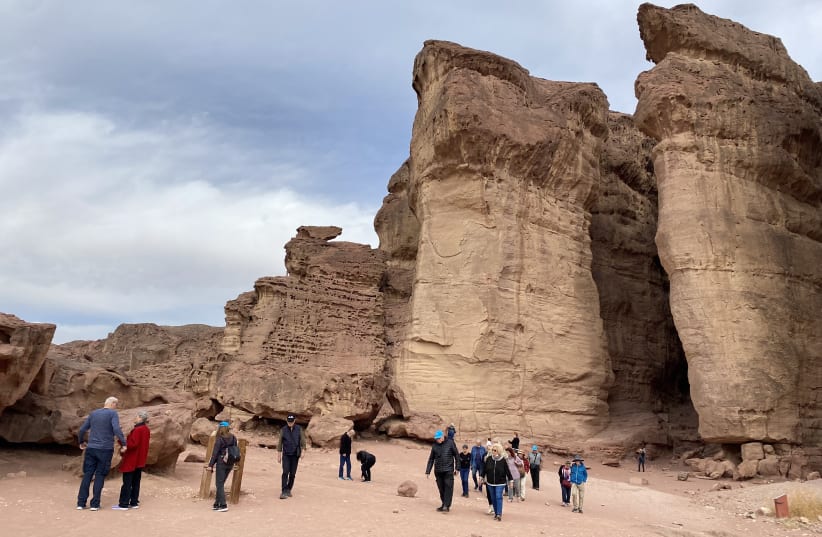While corona clearly has not been good for Israeli tourism, here and there we see buds of blossoming and hope. One of the places that has actually been revived in the past year is the tourist area of the Arava.
The Arava, once a road to a destination, has become a thriving tourist space that has grown out of the need of many hikers to momentarily disconnect from the hustle and bustle of cities, unwind and connect to the land.
This week I focus on one of my favorite parts of the desert region of our country: the southern Arava in the Eilot Regional Council.
The southern Arava is home to about 5,000 residents scattered in 10 kibbutzim, two community settlements and even a small family complex in the Uvda Air Force Base. The human mix here is particularly interesting, as it includes quite a few people who left everything behind and moved here to make the wilderness blossom, conquered nature and managed to establish a home and family in the desert.
One of the highlights of the southern Arava is Timna Park. Timna, which you must have visited at least once in your life as part of one school trip or another, is nothing more than a natural gem in the heart of the red valley. The park, which is not far from Eilat, covers an area of 70 sq.k.


Some fascinating geological and archaeological discoveries have been found in the park. It can be said that it is an attraction that combines different types of landscapes and animals, archaeological finds and remains, such as the Pillars of Solomon, the arches, the chariots, the “Mushroom,” the Slaves’ Hill and the temple to the goddess Hathor. The fascinating finds discovered in Timna offer a rare glimpse into the ancient period, in which copper mines among the most ancient found around the world operated.
Timna has a renewed visitor center where hikers gather and can take tips and hear explanations from Ron Bernstein, the park ranger, just before they embark on one of the 25 hiking trails around the park. The routes you will find are varied, some are suitable for families, others actually appeal to the well-traveled, and, of course, there are also single tracks for cyclists.
The winter period is the most comfortable, in my opinion, to hike in Timna. The comfortable weather makes it easy to walk from attraction to attraction even in the afternoon. Since the park is huge, you can do a three-hour road trip that will include the highlight of the park: The “Mushroom,” Solomon’s Pillars, the Chariots, the Sphinx, the Arches and the Screw. And since everything here is regulated and controlled, it is possible to stay there even in the evening – so the sites come to life with lighting. After the round you can stop at the artificial lake to refill your batteries and colored sand bottles.
If this sounds a bit intimidating to you, there are quite a few guided tours that leave from the park’s visitor center that include explanations of the terrain, the copper mines that operated on the site and the park’s fascinating history. Guided tours depart almost every day of the week, so you can choose from sunset walks, lantern tours and star gazing.
A new tour you should know about is the 12 Tribes Tour. It begins at the Mushroom Site – where you can learn briefly about, and see a demonstration of, the branching and physical copper extraction process that they worked hard on about 6,000 years ago in Timna. Copper is actually the first metal that man used frequently, and in order to extract it one had to look for unique minerals that included copper, mine them, and from them extract copper.
You can also hear about a new find found in Timna – a crimson-dyed cloth recently found in Slaves’ Hill.
From there, the tour continues to Ohel Mo’ed (Tent of Meeting) – a faithful restoration of the Ohel Mo’ed that was used by the Israelites in the desert and is written about in the Bible. Apart from what can be seen with your eyes, in the tent you will hear about the story of the Tabernacle, the work of the priests, and the holy vessels that were in it.
From there you move on to the last stop – a visit to the lake, where travelers will be offered hot tea and a small bottle to fill with colored sand.
Tour fee: NIS 49 for children, NIS 59 for adults, with advance registration.
Since the park is lovely even at night, those who are interested can choose the full experience and sleep in Timna. Around the lake there are guest rooms, cool caravans, air-conditioned tents and an organized camping complex.
Also, every Saturday during January there will be “Timna Chill Out” events. Which means that after you walk in the park you can go to the lake area and enjoy the chill-out music, activities for the kids, snacks in the park café and more.
Park opening hours: Every day of the week from 8 a.m. to 4 p.m. Tours in the evening.
Entry fee: NIS 49 for adults, NIS 39 for children. The ticket includes a small bottle to fill with colored sand and is effective for three days in a row.


A SHORT drive from Timna is the southernmost kibbutz in the country – Kibbutz Eilot. The kibbutz, which borders the city of Eilat, offers quite a few attractions and accommodation options for traveling families and couples.
In Eilot, there are 41 vacation units in a rural style and in different sizes that are suitable for anyone who wants to incorporate a hint of a kibbutz experience in their trip.
The units have a charming green space with shaded seating spaces, hammocks and barbecue areas. If you are staying in the units, you can enter the outdoor and indoor pool of the U SPLASH hotel, which is also located in the kibbutz.
You will get the full kibbutz experience when you arrive to eat in the kibbutz dining room, where you can see between the buffet stalls the members of the kibbutz who returned from the fields, the children on their way to school, and enjoy the unique experience.
Price for accommodations: NIS 500 to NIS 900 per couple, including breakfast; during this season the price is NIS 600 to NIS 700 per couple per night on weekends.
THE BEST way to get to know Eilot today is to look at the not so distant past – June 1955 – when a group of 15 young people from the HaKibbutz HaMeuhad union of kibbutzim decided to head down to Eilat. The group of pioneers called the “Grouped Company” was stationed in the area and engaged in agriculture. In 1959, after not easy years, the kibbutz was moved to its current location. You can hear about the courage of the company members, the challenges and the pioneering spirit in the Bereshit huts.
The huts are a short walk from the dining room. The hut that was recently renovated was formerly the kibbutz’s first dining room. The old hut has undergone many incarnations, including serving as a secretariat and even a storage room. Today it stands proudly and pays homage to the old members who survived the desert and established a thriving kibbutz. The hut includes a café that serves as a local parliament for the kibbutz’s veterans, a documentation room and a multigenerational wood workshop.
In the documentation room you can learn, through photos and videos, about the first settlers. This is a great opportunity to hear from the veterans about life then and today in a cooperative kibbutz and the traditions that have been preserved to this day.
The tour also includes a visit to the nearby workshop, where the veterans meet with the youth of Eilot for an intergenerational workshop that deals with recycling.
Tour fee: NIS 65 per person with advanced registration, includes coffee and cake
If you want to add extra value to a tour of the Bereshit huts, you can book an experiential carpentry workshop with Rafi Saar.
Saar, who has already been nicknamed “Grandpa Rafi” by the members, is a veteran of the kibbutz who spent most of his life in agriculture. After he retired and hugged his first grandson, he decided to dedicate himself to one of his hobbies and began making wooden toys with his own hands.
After specializing and perfecting the toys, he opened a workshop in which he offers carpentry workshops to the kibbutz members and visitors.
At the beginning of each workshop, which lasts about an hour and a half, Saar distributes to each participant a creative kit from which he will create a wooden toy under his guidance. During the workshop, the participants polish the wood, glue, assemble and paint – it is a real experience for all ages.
Workshop fee: NIS 250 per person
Details: 052-276-6014
Another experience not to be missed if you travel in the area on weekends: Every Friday, Kibbutz Eilot hosts a farmers’ market with local produce, fruits and vegetables, and food and drink stalls. The market includes the produce of Arava farmers without price gaps and directly from the farmer, which you can enjoy in your home or eat in a picnic on the adjacent lawn.
Among the stalls, you will find hydroponic crops, organic produce and freshly picked dates. There is also a ready-made food fair in the market, where you can buy food by weight that comes from the Kapot Tmarim kibbutz restaurant.
When? Every Friday, 8 a.m. to 2 p.m.
Translated by Tzvi Joffe.
